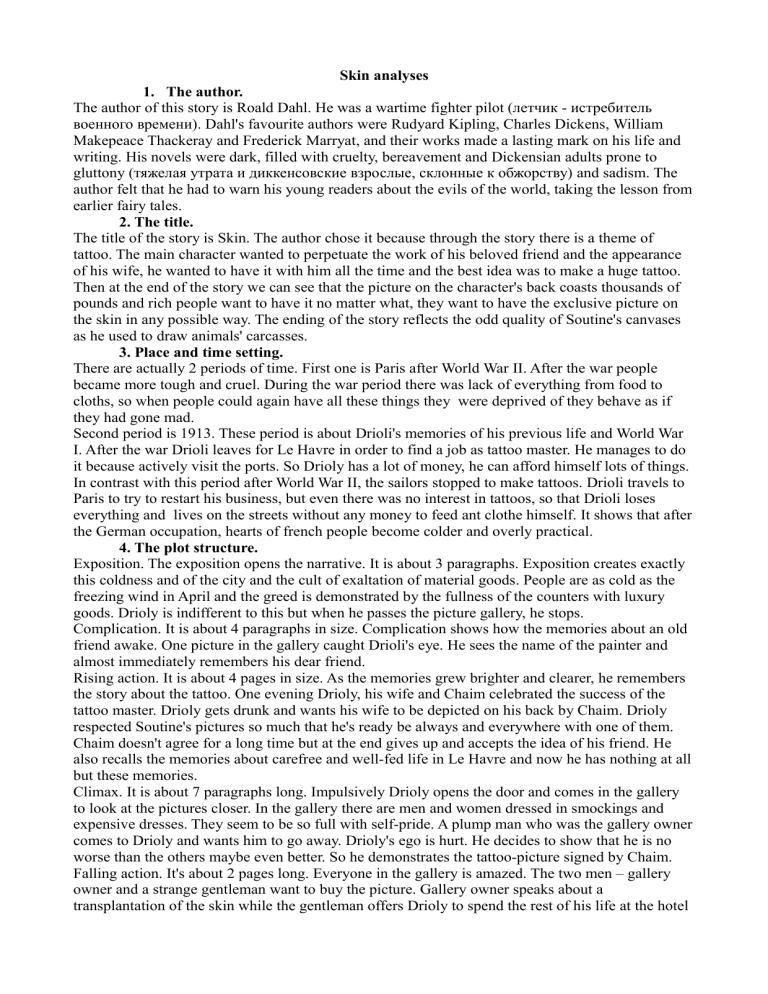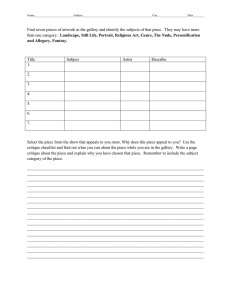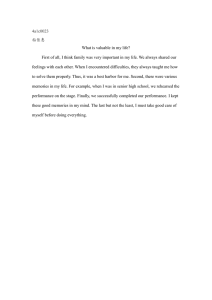
Skin analyses 1. The author. The author of this story is Roald Dahl. He was a wartime fighter pilot (летчик - истребитель военного времени). Dahl's favourite authors were Rudyard Kipling, Charles Dickens, William Makepeace Thackeray and Frederick Marryat, and their works made a lasting mark on his life and writing. His novels were dark, filled with cruelty, bereavement and Dickensian adults prone to gluttony (тяжелая утрата и диккенсовские взрослые, склонные к обжорству) and sadism. The author felt that he had to warn his young readers about the evils of the world, taking the lesson from earlier fairy tales. 2. The title. The title of the story is Skin. The author chose it because through the story there is a theme of tattoo. The main character wanted to perpetuate the work of his beloved friend and the appearance of his wife, he wanted to have it with him all the time and the best idea was to make a huge tattoo. Then at the end of the story we can see that the picture on the character's back coasts thousands of pounds and rich people want to have it no matter what, they want to have the exclusive picture on the skin in any possible way. The ending of the story reflects the odd quality of Soutine's canvases as he used to draw animals' carcasses. 3. Place and time setting. There are actually 2 periods of time. First one is Paris after World War II. After the war people became more tough and cruel. During the war period there was lack of everything from food to cloths, so when people could again have all these things they were deprived of they behave as if they had gone mad. Second period is 1913. These period is about Drioli's memories of his previous life and World War I. After the war Drioli leaves for Le Havre in order to find a job as tattoo master. He manages to do it because actively visit the ports. So Drioly has a lot of money, he can afford himself lots of things. In contrast with this period after World War II, the sailors stopped to make tattoos. Drioli travels to Paris to try to restart his business, but even there was no interest in tattoos, so that Drioli loses everything and lives on the streets without any money to feed ant clothe himself. It shows that after the German occupation, hearts of french people become colder and overly practical. 4. The plot structure. Exposition. The exposition opens the narrative. It is about 3 paragraphs. Exposition creates exactly this coldness and of the city and the cult of exaltation of material goods. People are as cold as the freezing wind in April and the greed is demonstrated by the fullness of the counters with luxury goods. Drioly is indifferent to this but when he passes the picture gallery, he stops. Complication. It is about 4 paragraphs in size. Complication shows how the memories about an old friend awake. One picture in the gallery caught Drioli's eye. He sees the name of the painter and almost immediately remembers his dear friend. Rising action. It is about 4 pages in size. As the memories grew brighter and clearer, he remembers the story about the tattoo. One evening Drioly, his wife and Chaim celebrated the success of the tattoo master. Drioly gets drunk and wants his wife to be depicted on his back by Chaim. Drioly respected Soutine's pictures so much that he's ready be always and everywhere with one of them. Chaim doesn't agree for a long time but at the end gives up and accepts the idea of his friend. He also recalls the memories about carefree and well-fed life in Le Havre and now he has nothing at all but these memories. Climax. It is about 7 paragraphs long. Impulsively Drioly opens the door and comes in the gallery to look at the pictures closer. In the gallery there are men and women dressed in smockings and expensive dresses. They seem to be so full with self-pride. A plump man who was the gallery owner comes to Drioly and wants him to go away. Drioly's ego is hurt. He decides to show that he is no worse than the others maybe even better. So he demonstrates the tattoo-picture signed by Chaim. Falling action. It's about 2 pages long. Everyone in the gallery is amazed. The two men – gallery owner and a strange gentleman want to buy the picture. Gallery owner speaks about a transplantation of the skin while the gentleman offers Drioly to spend the rest of his life at the hotel in Cannes surrounded by luxury. All he need is demonstrate the picture to the guests. This scene shows how people are obsessed with possession. They need only the picture, never minding about the idea of it, the importance for Drioly. The owner doesn't even think about old man's life and health. Resolution. It is about 5 paragraphs in size. Drioly thinks for a moment about the offers while the gentleman suggest having a dinner. Drioly agrees. Denouement. It is 1 paragraph in size. Some time later the picture of Drioly's wife appears at the auction in Buenos Aires. No one has ever seen Drioly since this time. We can only guess whether he was still alive or not. 5. Point of view. The story is narrated from Drioly. There are several inserts of the author where he adds some description and shares information. Readers are allowed to know enough to understand what is going on except of the end of the story. From my point of view we are allowed to imagine what was in the end: whether Drioly was killed or he agreed to a transplant for some money. 6. Atmosphere. As I already said, at the beginning of the story the weather creates the atmosphere of changing of values and characters of people in Paris. It is also shown by Drioly's memories of post-war life in 1913 in comparison with life in 1946. The atmosphere of the gallery and the description of people there in comparison with Drioly's description shows the difference between people from various social classes. 7. Characters. We allowed to know some important facts about the main character. Through his memories we can see a part of his previous life. We are even given the description of Chaim Soutine: very broad and high-cheeked, with a wide coarse nose. This broadness of the cheeks was accentuated by the ears which stood out sharply from the head. And then he had the narrow eyes, the black hair, the thick sullen mouth of a Kalmuck, but the hands the hands were always a surprise, so small and white like a lady's, with tiny thin fingers. The description of the main character is given at the beginning of the story: The old man who was called Drioli shuffled painfully along the sidewalk of the Rue de Rivoli. He was cold and miserable, huddled up like a hedgehog in a filthy black coat, only his eyes and the top of his head visible above the turned-up collar. 8. Language of the author. The story is full of dialogs. We can also see that it moves from past (Drioly's memories) to the present. It was easy and pleasant for me to read because descriptions and actions were balanced.




